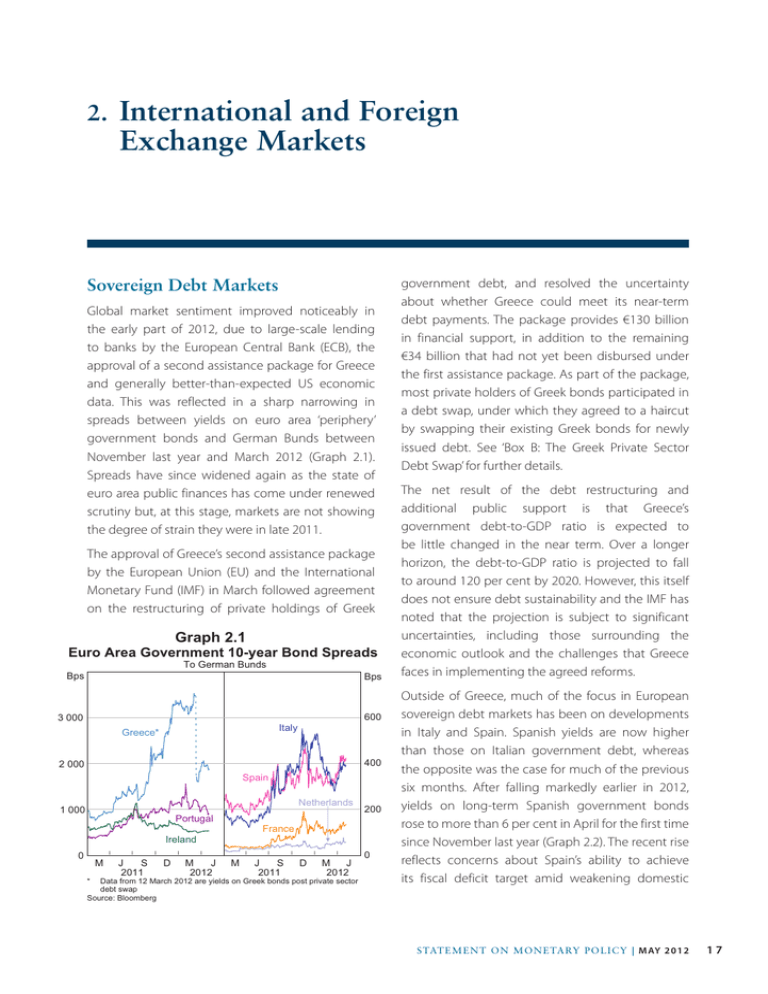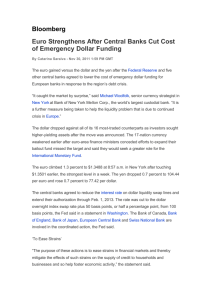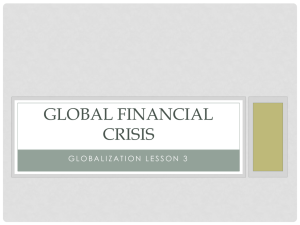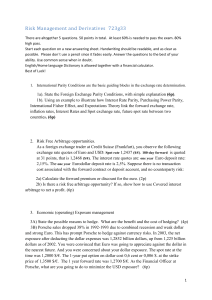International and Foreign Exchange Markets 2. Sovereign Debt Markets
advertisement

2.International and Foreign Exchange Markets Sovereign Debt Markets Global market sentiment improved noticeably in the early part of 2012, due to large-scale lending to banks by the European Central Bank (ECB), the approval of a second assistance package for Greece and generally better-than-expected US economic data. This was reflected in a sharp narrowing in spreads between yields on euro area ‘periphery’ government bonds and German Bunds between November last year and March 2012 (Graph 2.1). Spreads have since widened again as the state of euro area public finances has come under renewed scrutiny but, at this stage, markets are not showing the degree of strain they were in late 2011. The approval of Greece’s second assistance package by the European Union (EU) and the International Monetary Fund (IMF) in March followed agreement on the restructuring of private holdings of Greek Graph 2.1 Euro Area Government 10-year Bond Spreads To German Bunds Bps Bps 600 3 000 Italy Greece* 400 2 000 Spain Netherlands 1 000 200 Portugal France Ireland l 0 M * l J S 2011 l l D l M J 2012 l M l J S 2011 l l D l M J 2012 Data from 12 March 2012 are yields on Greek bonds post private sector debt swap Source: Bloomberg 0 government debt, and resolved the uncertainty about whether Greece could meet its near-term debt payments. The package provides €130 billion in financial support, in addition to the remaining €34 billion that had not yet been disbursed under the first assistance package. As part of the package, most private holders of Greek bonds participated in a debt swap, under which they agreed to a haircut by swapping their existing Greek bonds for newly issued debt. See ‘Box B: The Greek Private Sector Debt Swap’ for further details. The net result of the debt restructuring and additional public support is that Greece’s government debt-to-GDP ratio is expected to be little changed in the near term. Over a longer horizon, the debt-to-GDP ratio is projected to fall to around 120 per cent by 2020. However, this itself does not ensure debt sustainability and the IMF has noted that the projection is subject to significant uncertainties, including those surrounding the economic outlook and the challenges that Greece faces in implementing the agreed reforms. Outside of Greece, much of the focus in European sovereign debt markets has been on developments in Italy and Spain. Spanish yields are now higher than those on Italian government debt, whereas the opposite was the case for much of the previous six months. After falling markedly earlier in 2012, yields on long-term Spanish government bonds rose to more than 6 per cent in April for the first time since November last year (Graph 2.2). The recent rise reflects concerns about Spain’s ability to achieve its fiscal deficit target amid weakening domestic STATE ME N T O N MO N E TARY P O L ICY | m ay 2 0 1 2 17 Graph 2.2 Graph 2.3 10-year Government Bond Yields % Foreign Holdings of Central Government Debt Securities % Share of total outstanding Italy 7 7 6 6 % % 55 55 Italy Spain 5 5 4 4 45 45 Spain 35 l 3 M l J S 2010 l l D l M l J S 2011 l l D l 3 M J 2012 Source: Bloomberg economic activity. The Spanish Government’s fiscal deficit target for 2012, agreed with the European Commission, is now 5.3 per cent of GDP, from the previously agreed 4.4 per cent. In late April, Standard & Poor’s downgraded Spain’s sovereign credit rating two notches from A to BBB+. At around 4 per cent of GDP, Spanish central government bond maturities for the remainder of the year are lower than the equivalent ratios for some other euro area members, and the Spanish Government has already raised half of its anticipated 2012 long-term funding requirements. Italian government bond yields also remain elevated. Yields had declined from their 2011 peaks as investors showed some confidence in the new Italian Government’s fiscal reforms, before partly retracing this fall. The composition of ownership of Italian and Spanish government bonds has shifted considerably, with the share of foreign holdings falling over recent quarters (Graph 2.3). The rapid shift in these shares suggests that foreign investors have been selling government securities, as well as letting their existing positions mature. In contrast, Italian and Spanish banks have purchased a large volume of government securities since the ECB’s first 3-year loan operation in December (Graph 2.4). Spanish banks purchased around €80 billion of European government securities in the four months to March, while Italian banks purchased around €65 billion. This compares with gross issuance of €85 billion 18 R es erv e Ba nk of Aus t r a l i a 35 25 25 2002 2004 2006 2008 2010 2012 Sources: Bank of Italy; RBA; Spanish Treasury Graph 2.4 Net Purchases of European Government Debt Securities By banks* €b €b Italian banks 20 20 First 3-year LTRO** 10 10 0 0 -10 -10 €b €b Spanish banks 20 20 10 10 0 0 -10 -20 -10 M J S 2011 D M 2012 * Monetary financial institutions ** Longer-term refinancing operation Source: European Central Bank and €165 billion by the Spanish and Italian central governments over the same period. Officials from the IMF and European Commission have completed their third review of Portugal, noting that the program is on track overall but risks remain. One of these is the ability of Portugal to regain market access in 2013, as is currently assumed under its assistance package. Spreads between yields on Portuguese government bonds and German government bonds are lower than they were at the beginning of the year, but remain elevated. -20 French government bond spreads have widened recently, partly because of uncertainty about the political situation. The French presidential election is to be held on 6 May. In the Netherlands, spreads widened briefly after the coalition government resigned amid difficulty negotiating austerity measures intended to reduce the budget deficit to 3 per cent of GDP by 2013. Even though spreads in the euro area have widened recently, the ECB has not purchased sovereign debt under its Securities Markets Program since early March. Purchases were reduced significantly after the ECB’s 3-year loan operations (Graph 2.5). Euro area policymakers have continued to increase the amount of financial assistance that could potentially be provided to member states. The joint lending capacity of the European Financial Stability Facility (EFSF) and the permanent European Stability Mechanism (ESM) was increased to €700 billion, from €500 billion. In effect, the €500 billion in lending capacity of the ESM has been added to existing EFSF commitments of €200 billion for the assistance programs in Greece, Ireland and Portugal. In addition, a further €100 billion has already been committed by European governments through the bilateral Greek loan facility and the European Financial Stabilisation Mechanism (EFSM). Euro area members have also committed to provide €150 billion in additional bilateral contributions to the IMF. Government bond yields in the major advanced economies remain at historically low levels (Graph 2.6). Yields on 10-year US and UK government bonds are back around 2 per cent, after temporarily rising in March. German 10-year government bond yields have fallen to a historical low, and short-term German government paper continues to trade at yields of around zero. Spreads on US dollardenominated debt issued by emerging market sovereigns have narrowed over the past few months, but have not fully unwound the sharp rise from August last year (Graph 2.7). Graph 2.6 10-year Government Bond Yields % % UK 3.5 3.5 3.0 3.0 Germany 2.5 2.5 US 2.0 1.5 l l M l J l S D ECB Securities Markets Program 1.5 l M 2011 Source: Bloomberg Graph 2.5 2.0 J 2012 Graph 2.7 Euro area bond purchases €b €b 50 200 Outstanding US Dollar-denominated Sovereign Debt Spreads To US government bonds, duration matched Bps Emerging Asia Emerging Europe Latin America 1 000 (RHS) 40 160 30 120 20 80 10 40 Bps 1 000 800 800 600 600 400 400 200 200 Weekly purchases (LHS) 0 l J l S D 2010 l l M Source: European Central Bank l J l S 2011 l D l M J 2012 0 0 l l 2009 l l 2012 l l 2009 l l 2012 l l 2009 l l 0 2012 Source: Thomson Reuters STATE ME N T O N MO N E TARY P O L ICY | m ay 2 0 1 2 19 Central Bank Policy of much shorter loans). This was the second of the two scheduled 3-year lending operations by the ECB, with the total amount supplied to banks under the two operations surpassing €1 trillion. Prior to the second operation, the ECB announced a further temporary broadening of eligible collateral to include some lower-rated securities and bank loans in some instances. These measures were adopted in seven euro area countries and are estimated to have increased banks’ effective funding capacity by around €200 billion. A number of central banks have eased monetary policy in recent months (Table 2.1). The Central Bank of Brazil lowered its policy rate target by 75 basis points on two occasions, bringing the cumulative reduction to 350 basis points since August 2011. The Reserve Bank of India (RBI) reduced its policy rate by 50 basis points, to 8 per cent, which was the first cut in around three years. In addition, the People’s Bank of China (PBC) and the RBI lowered banks’ reserve requirement ratios, following similar moves in late 2011/early 2012. Lending through the national central banks of Italy and Spain has increased particularly sharply, with a significant increase in lending also recorded by the French central bank (Graph 2.8). However, not all The ECB provided €530 billion of 3-year loans to banks at its policy rate in February (of which around €200 billion represented maturities and extensions Table 2.1: Policy Rates Current level Per cent Change from 2011 peak Basis points Euro area 1.00 0.05 ↓ ↓ Dec 11 Japan Oct 10 –50 – 0.125 ↓ Dec 08 – 9.00 ↓ Apr 12 –350 United States Brazil Canada 1.00 ↑ Sep 10 – China 6.56 ↑ Jul 11 – India 8.00 ↓ Apr 12 –50 Indonesia 5.75 ↓ Feb 12 –100 Israel 2.50 ↓ Jan 12 –75 Malaysia 3.00 ↑ May 11 – Mexico 4.50 ↓ Jul 09 – New Zealand 2.50 ↓ Mar 11 –50 Norway 1.50 ↓ Mar 12 –75 Russia 8.00 ↓ Dec 11 –25 South Africa 5.50 ↓ Nov 10 – South Korea 3.25 ↑ Jun 11 – Sweden 1.50 ↓ Feb 12 –50 Switzerland 0.00 ↓ Aug 11 –25 1.875 ↑ Jun 11 – Thailand 3.00 ↓ Jan 12 –50 United Kingdom 0.50 ↓ Mar 09 – Taiwan Source: central banks 20 Most recent change R es erv e Ba nk of Aus t r a l i a Graph 2.8 Government Financial Policy ECB Lending to Banks* By national central bank €b €b 300 300 Germany 250 250 Spain** Italy 200 200 150 France** 150 Ireland 100 50 100 Belgium 50 Greece Portugal 0 0 2009 2010 2011 2012 2009 2010 2011 2012 * Lending provided through monetary policy operations only ** Month-average; France is month-end prior to September 2010 Sources: RBA; central banks of the lending by individual national central banks has gone to locally owned banks, particularly in the periphery. It appears that some banks have increased borrowing from central banks in countries in which they have subsidiaries, whereas previously they would typically have borrowed from the central bank in the country where their head office is located. As discussed above, some banks in euro area periphery countries appear to have used ECB funding to purchase sovereign debt, placing downward pressure on government bond yields for those countries. Banks also made significant use of the funds to meet redemptions of maturing debt. The US Federal Reserve has purchased around US$315 billion of longer-term US Treasuries as part of its US$400 billion Maturity Extension Program, which is due to be completed by the end of June. The Bank of England has completed the £50 billion expansion of its Asset Purchase Facility, bringing total gilt purchases under the facility to £325 billion. The Bank of Japan (BoJ) also expanded its Asset Purchase Program by a total of ¥15 trillion to ¥70 trillion (US$870 billion). The BoJ has so far purchased around ¥50 trillion of assets under the program, which is due to be completed in June 2013. The Federal Reserve announced the results of the latest stress tests for large US financial institutions. Of the 19 participating institutions, 15 passed the exercise, indicating that they would meet minimum capital ratios under stressed market conditions. The capital plans, including planned dividend payments and share buybacks, of most institutions were approved. However, a few banks’ plans were rejected, including Citigroup. These banks were required to submit new capital plans for approval. The five largest mortgage servicers in the United States (JPMorgan, Citigroup, Bank of America, Wells Fargo and Ally Financial) reached a US$25 billion settlement with the federal and almost all state governments to address mortgage servicing and foreclosure abuses. The banks will transfer around US$20 billion to mortgage borrowers through principal reductions and other forms of relief, as well as refinance some loans in negative equity. The remainder will be paid to the governments to cover costs resulting from mishandled foreclosures and to help fund programs to aid troubled borrowers. The banks did not receive immunity from further legal action. The US Government sold approximately US$6 billion of its common equity stake in the insurer AIG. The Government has divested stock when AIG’s share price exceeds the price at which it was acquired. The sale reduced the Government’s ownership stake from 77 per cent to 70 per cent. AIG has also paid the US Treasury US$8.5 billion to retire preferred shares. The Federal Reserve has completed the sale of the Maiden Lane II portfolio (a special purpose vehicle created to remove mortgage-backed securities from AIG’s balance sheet) to private investors, resulting in a US$2.8 billion net profit to the US Government. The Federal Reserve also sold part of its Maiden Lane III collateralised debt obligations portfolio. STATE ME N T O N MO N E TARY P O L ICY | m ay 2 0 1 2 21 Graph 2.10 Credit Markets In contrast to sovereign debt markets, conditions in private credit markets have improved consistently over the past few months, bolstered by the significant increase in liquidity provided by the ECB’s 3-year lending operations. The cost of borrowing euros in short-term unsecured interbank markets has fallen to the lowest level since August 2011 (Graph 2.9). The cost of swapping euros into US dollars in the foreign exchange market (relative to the cost of unsecured interbank funding) has continued to fall (Graph 2.10). In addition, US money market funds, which are significant providers of US dollar liquidity, have slightly increased their holdings of euro area bank debt over recent months. These holdings had fallen significantly over the second half of 2011 (Graph 2.11). At the same time, banks’ recourse to central bank US dollar liquidity facilities has declined to around US$30 billion, from US$110 billion earlier in the year. In part, these developments have reflected both an easing of credit quality concerns and the fact that demand for US dollars from European banks has declined as they have shed US dollar assets. As sentiment towards euro area banks improved following the ECB’s 3-year lending operations, banks re-entered the bond market in order to help finance sizeable maturities in early 2012. Euro area banks have issued US$230 billion of bonds so far this year (Graph 2.12). While this is already more Cost of Swapping Euros into US Dollars* 3-month EUR/USD foreign exchange swap basis Bps Bps 250 200 200 150 150 100 100 50 50 0 0 l -50 To overnight indexed swaps, 3-month maturity Bps Bps 200 200 150 150 100 100 50 50 2007 2008 l 2009 l 2010 Source: Bloomberg 22 R es erv e Ba nk of Aus t r a l i a l 2010 2011 2012 -50 * Relative to the cost of unsecured interbank funding Source: Bloomberg Graph 2.11 US Prime Money Market Funds Estimated value of euro area bank exposures, by country US$b Germany Netherlands France Rest of euro area US$b 400 400 300 300 200 200 100 100 0 0 J J A S 2011 O N D J F 2012 M Sources: JPMorgan; RBA Euro Area Bank Bond Issuance US$b 0 l 2011 2012 Covered Guaranteed Unguaranteed Maturities US$b 100 100 50 50 0 0 -50 -50 -100 -100 -150 l l 2009 Graph 2.12 Euro Unsecured Interbank Borrowing Spread l l 2008 Graph 2.9 0 250 Reduction in cost of central bank swap facility M J S 2010 D M J S 2011 D M Sources: Bloomberg; Dealogic; RBA; Thomson Reuters J S 2012 D -150 than the amount issued in the second half of 2011, it compares with around US$420 billion in maturing bonds. As noted above, banks made substantial use of the ECB’s lending operations to finance maturities. Corporate bond issuance more broadly also picked up in the March quarter in both the United States and the euro area, with US issuance the strongest in three years (Graph 2.13). The increased issuance is consistent with lower US and euro area bond yields across a range of sectors and classes of risk (Graph 2.14). Graph 2.13 Corporate Bond Issuance US$b US$b US 200 200 150 150 100 100 50 50 US$b Equities Equity prices rose strongly in the first few months of the year as market sentiment improved, supported by better-than-expected US data, before declining more recently on renewed European sovereign debt concerns and a winding back of expectations of further monetary policy easing in the United States. Global equity prices have increased by 9 per cent so far this year, after falling by 9 per cent over 2011 (Table 2.2, Graph 2.15). Euro area equity prices have underperformed in 2012, partly because of recent weakness in financial stocks (see below). In contrast, Japanese markets have outperformed over 2012 to date as the yen depreciated, but share prices there have also fallen in recent weeks. Table 2.2: Changes in International Share Prices Per cent Over 2011 Since end 2011 6 9 – S&P 500 0 12 – NASDAQ –2 17 –18 3 –6 3 –17 11 –11 2 –15 9 –22 11 US$b Euro area 200 United States 150 150 – Dow Jones 100 100 50 50 0 0 200 2007 2008 2009 2010 2011 2012 n Sub-investment-grade corporates n Covered n Guaranteed financials n Investment-grade corporates n Unguaranteed financials – STOXX United Kingdom – FTSE Sources: Bloomberg; Dealogic; RBA; Thomson Reuters Japan Graph 2.14 – Nikkei Corporate Bond Yields % Euro area US % Euro area 30 30 25 25 'Junk' B Canada – TSE 300 Australia – ASX 200 China 20 20 15 15 10 10 – Emerging Asia –16 12 5 – Latin America –13 8 – Emerging Europe –19 5 –9 9 Financials 5 Investment grade* 0 l l 2008 l l 2010 l l 2012 2008 l l l 2010 * Non-financial corporates Sources: Bank of America Merrill Lynch; Bloomberg; RBA l 2012 0 – China A MSCI indices – World Source: Bloomberg STATE ME N T O N MO N E TARY P O L ICY | m ay 2 0 1 2 23 Graph 2.15 Major Share Price Indices 1 January 2011 = 100 Index Index S&P 500 110 110 FTSE 100 Chinese share prices have performed better than those in other emerging markets in recent months, after underperforming both developed and emerging markets in 2011 (Graph 2.17). Concerns about slower Chinese growth appear to have been offset by speculation about further monetary policy easing. In Latin America, equity prices fell in Brazil as the government extended a tax on capital inflows. 100 90 90 Nikkei 80 80 Euro STOXX 70 l l M l J Source: Bloomberg l S l D 70 M 2011 J 2012 Banking sector share prices have been particularly sensitive to shifts in sentiment, with an initial improvement in 2012 giving way to steep falls more recently (Graph 2.16). Euro area bank share prices rose by around 20 per cent between the end of last year and early February 2012, but have unwound this increase in recent months. Despite recent falls, US bank share prices have outperformed the broader market since the start of the year, partly due to increased confidence in the sector after the Fed announced its latest bank stress test results (see section on ‘Government Financial Policy’). Earnings of large US banks in the March quarter were generally better than the market had expected, with strong Graph 2.17 Share Price Indices Local currencies, 1 January 2011 = 100 Index Graph 2.16 1 January 2011 = 100 Broad market Index Banks* 120 120 US 100 100 UK 80 80 Euro area 60 60 40 l M l J S 2011 l l D l M J 2012 l M l J S 2011 * US index is diversified financials Source: Bloomberg 24 R es erv e Ba nk of Aus t r a l i a 110 Index Emerging Europe 110 100 100 Latin America 90 90 Emerging Asia 80 80 China A l 70 M l J l S 2011 l D l M 70 J 2012 Sources: Bloomberg; MSCI Hedge Funds Share Price Indices Index trading revenues and an increase in mortgagerelated earnings at a number of banks offset by accounting losses on their own debt and derivative positions. Mergers and acquisitions earnings remain notably weak. Large European banks’ earnings reported for the March quarter were mixed. l l D l M J 2012 40 Global hedge funds recorded an average loss on investments of 2 per cent over the year to March, with a positive average return in the March quarter only partly offsetting losses recorded in mid to late 2011. Hedge funds have continued to underperform equity markets, which recorded positive total returns (including dividends) over the year. Funds under management increased to US$2.1 trillion over the March quarter, reflecting the combination of positive investment returns and an increase in investor contributions following a very small withdrawal in the December quarter (Graph 2.18). Graph 2.18 Global Hedge Funds US$b US$tr 750 1.8 Total funds under management (RHS) 500 1.2 250 0.6 0 0.0 Returns (LHS) -250 -0.6 Net investor flows (LHS) -500 1992 1996 2000 2004 2008 Q1 Q2 2012 Source: Hedge Fund Research, Inc. -1.2 Per cent Although global risk sentiment generally improved in the early part of 2012, the recently renewed concerns about the sustainability of European fiscal positions and uncertainty about China’s growth outlook have generally weighed on emerging market and commodity currencies and supported the US dollar (Table 2.3). Overall, the US dollar is broadly unchanged in trade-weighted terms since the beginning of the year (Graph 2.19). The euro had depreciated in late 2011 on increased concerns about the prospects for an orderly resolution to the euro area debt crisis, reaching a low point in mid January prior to the agreement on the Graph 2.19 US Dollar against Selected Currencies US$ per euro (LHS, inverted scale) 1.6 2.0 2000 US$ per UK pound (LHS, inverted scale) (RHS) 2003 l l l 2006 12 Indian rupee 19 8 6 4 Australian dollar Japanese yen –1 4 Indonesian rupiah 8 4 New Zealand dollar –1 3 South African rand 17 2 Mexican peso 12 2 6 2 Swedish krona 12 2 European euro 13 1 South Korean won 2 1 3 0 6 0 125 Philippine peso –1 0 Chinese renminbi –3 0 Singapore dollar 1 –1 New Taiwan dollar 2 –1 Canadian dollar 4 –1 UK pound sterling 3 –2 Majors TWI 6 1 Broad TWI 5 1 75 Yen per US$ l 21 Thai baht TWI* l Brazilian real Malaysian ringgit (RHS) l Since previous Statement Yen, Index 100 l Over the past year Swiss franc 1.2 2.4 After trading close to its previous high reached in late October, the Japanese yen depreciated by around 9 per cent against the US dollar between early February and mid March, largely in response to the BoJ’s decision to increase the size of its Asset Purchase Program and implement an explicit Table 2.3: Changes in the US Dollar against Selected Currencies Foreign Exchange US$ Greek debt package. Since then, notwithstanding renewed concerns about fiscal sustainability in certain euro area countries, the euro has traded within a fairly limited range against the US dollar and intraday volatility has declined to its lowest level since late 2007 (Graph 2.20). l l l 2009 l l 2012 * Indexed to 1 January 2007 = 100 Sources: Bloomberg; Board of Governors of the Federal Reserve System 50 Sources:Bloomberg; Board of Governors of the Federal Reserve System STATE ME N T O N MO N E TARY P O L ICY | m ay 2 0 1 2 25 Graph 2.20 Graph 2.21 Chinese Renminbi Intraday Range in EUR/USD Average daily range in month US¢ US¢ 2.5 2.5 Long-term average 2.0 2.0 1.5 1.5 1.0 1.0 0.5 0.5 Index Yuan Yuan per US$ (RHS, inverted scale) 120 6.5 115 6.8 110 7.1 105 7.4 TWI (LHS, 2007 average = 100) 0.0 0.0 2007 2008 2009 2010 2011 2012 100 95 7.7 l 2007 l 2008 l 2009 l 2010 l 2011 2012 Sources: BIS; Bloomberg; RBA Sources: Bloomberg; RBA medium-term inflation goal. More recently, a renewal of safe-haven flows into the yen has resulted in around half of the earlier depreciation being retraced. The yen’s nominal effective exchange rate is still high by historical standards although in real terms it remains around the centre of its range over the past three decades. Some renewal in safe-haven flows is also evidenced by the Swiss franc trading increasingly close to the 1.20 francs per euro ceiling imposed by the Swiss authorities last September. The Swiss National Bank (SNB) reiterated its commitment to enforce this ceiling in early April, after a small number of isolated transactions took place above the ceiling between market participants who did not have trading agreements with the SNB. On each occasion, a segmented market could be observed for a very short-lived period, as the banks that purchased Swiss francs for less than the 1.20 francs per euro rate did not receive the best market price. The pace of appreciation in the Chinese renminbi has slowed in recent months, with the exchange rate broadly unchanged against the US dollar and slightly lower on a trade-weighted basis since the start of the year (Graph 2.21). This has coincided with a softer economic outlook for China and a narrowing in China’s trade surplus. The renminbi remains around its highest level since 1994 in real effective terms, 26 R es erv e Ba nk of Aus t r a l i a reflecting relatively high inflation in China. In April, the PBC widened the renminbi’s daily trading band against the US dollar to 1 per cent above or below the daily reference rate (from 0.5 per cent), citing a desire to increase flexibility in the exchange rate in both directions as one reason for the decision. Pricing of non-deliverable forward contracts currently suggests little change in the renminbi against the US dollar in the near term. China reported an increase in its foreign exchange reserve holdings over the March quarter to US$3.3 trillion (Table 2.4). While the increase is likely to have included a modest valuation effect, it suggests that the PBC resumed its purchases of foreign exchange after indications that it sold foreign exchange in the final quarter of 2011 to support the renminbi. In late March, the Reserve Bank and the PBC signed a three-year bilateral local currency swap agreement valued at A$30 billion (CNY 200 billion), the main purpose of which is to support trade and investment between Australia and China, particularly in local currency terms.1 The PBC also signed a three-year bilateral local currency swap agreement with Turkey (valued at CNY 10 billion/US$1.6 billion), and extended and expanded existing swap agreements with Malaysia and Mongolia. 1 This was announced in an RBA Media Release on 22 March. Available at <http://www.rba.gov.au/media-releases/2012/mr-12-08.html>. 8.0 Table 2.4: Foreign Currency Reserves As at end March 2012 Three-month-ended change Level US$ equivalent (billions) Per cent US$ equivalent (billions) China(a) 124 3.9 3 305 Japan –10 –0.8 1 210 Russia 15 3.4 450 Taiwan 8 2.2 394 Brazil 12 3.6 355 South Korea 10 3.3 308 India –3 –1.1 260 Thailand 4 2.2 168 Indonesia 0 –0.1 103 Turkey 2 2.6 79 –2 –6.1 38 Chile (a)Foreign exchange reserves (includes foreign currency and other reserve assets) Sources: Bloomberg; CEIC; IMF; RBA In other developments designed to further the process of internationalising the renminbi, the Chinese authorities significantly increased the total size of foreign investment permitted in Mainland listed bond and equity markets under both the Qualified Foreign Institutional Investors (QFII) scheme for investment using foreign currency and the equivalent scheme for investment using renminbi obtained in the offshore market (RQFII). The authorities also extended the renminbi trade settlement scheme to include all Chinese exporters (the scheme was previously available only to selected Chinese exporters). At a summit held in late March, the BRICS nations (Brazil, Russia, India, China and South Africa) agreed to promote lending by their respective development banks in local currency terms, which would include the China Development Bank offering renminbi loans to the other BRICS nations. After appreciating modestly earlier in the year, most other emerging Asian currencies have depreciated against the US dollar over recent months and generally remain below their mid 2011 peaks. In contrast, the Singapore dollar has appreciated modestly, supported by the Monetary Authority of Singapore’s decision to increase the pace of appreciation in the nominal effective exchange rate. The Indian rupee depreciated relatively sharply, reflecting ongoing concerns about growth and India’s reliance on external funding as well as a greater-than-expected monetary policy easing. The currency is now around 17 per cent below its 2011 peak, and only 2 per cent above the multi-decade low it reached in mid December (Graph 2.22). Consistent with the ongoing weakness in the rupee, India’s foreign currency reserves declined further over the March quarter, in contrast to the modest reserve accumulation recorded in most other emerging Asian economies. The currencies of most Latin American countries have also depreciated in recent months. The Brazilian real has depreciated particularly sharply, falling by 12 per cent since late February to be 20 per cent below its mid 2011 peak. The real’s sharp depreciation has been partly driven by policy measures including central bank purchases of US dollars in the foreign exchange market and the extension of an existing tax on capital inflows, as well as monetary policy easing. STATE ME N T O N MO N E TARY P O L ICY | m ay 2 0 1 2 27 Graph 2.22 Selected Currencies against the US Dollar Table 2.5: Changes in the Australian Dollar against Selected TWI Currencies Per cent 1 January 2007 = 100 Index Index Brazil Chile Singapore 125 125 100 100 India South Africa 75 South Korea l l 2008 l l 2010 l l 2012 l 2008 l l 2010 l 50 2012 Source: Bloomberg Australian Dollar The Australian dollar remains at a high level by historical standards, supported by the continued high level of the terms of trade and strong foreign demand for Commonwealth Government securities (CGS) (Graph 2.23). Graph 2.23 Australian Dollar US$, Euro, Pound 1.20 Yen, Index Euro per A$* (LHS) 200 US$ per A$ (LHS) 0.90 150 0.60 100 0.30 Pound per A$ TWI** (LHS) (RHS) Yen per A$ 1992 1997 2002 50 (RHS) 0.00 1987 2007 0 2012 * Deutsche Mark spliced on to euro prior to 4 January 1999 ** Indexed to post-float average = 100 Sources: RBA; Thomson Reuters; WM/Reuters The currency remains around levels seen at the start of the year (Table 2.5) notwithstanding a likely further decline in the terms of trade in the March 28 US dollar Chinese renminbi 75 50 Japanese yen Indonesian rupiah Indonesia R es erv e Ba nk of Aus t r a l i a Over 2011 Since end 2011 –5 5 0 3 0 1 –5 1 European euro 3 0 Thai baht 5 –1 Swiss franc 0 –1 South Korean won 3 –2 Canadian dollar 2 –2 UK pound sterling 0 –3 New Zealand dollar 0 –3 Malaysian ringgit 3 –3 Singapore dollar 1 –3 TWI 0 1 Sources: Bloomberg; Thomson Reuters; WM/Reuters quarter (after falling by around 5 per cent in the December quarter), increased concerns about a possible slowdown in commodities demand from China and lower domestic interest rates. Consistent with developments in other currency markets, volatility in the Australian dollar has been well below the levels observed during the second half of 2011. Capital Flows Net capital inflows in the December quarter were directed largely towards the public sector, consistent with the trend over the past two years (Graph 2.24). This reflected continued strong foreign demand for CGS, with around three-quarters of the stock of CGS on issue currently held by non-residents. This net inflow to the public sector was partly offset by a small net outflow from the private sector, reflecting a sizeable net outflow from the Australian banking sector. Graph 2.24 Australian Capital Flows* Net inflows, per cent of GDP % % Current account deficit 8 8 Public 4 4 0 0 The net outflow from Australian banks in the December quarter was the result of a net reduction in foreign deposits that followed inflows in previous quarters and the net repayment of loans and maturing portfolio debt to foreign investors. In contrast, there were strong debt and equity inflows to Australian private non-financial corporations, with both the mining and non-mining sectors receiving net inflows in the quarter. Private** -4 -8 -4 2006 2007 2008 2009 2010 2011 -8 * Excludes official and other RBA flows ** Adjusted for US dollar swap facility in 2008 and 2009 Sources: ABS; RBA STATE ME N T O N MO N E TARY P O L ICY | m ay 2 0 1 2 29





